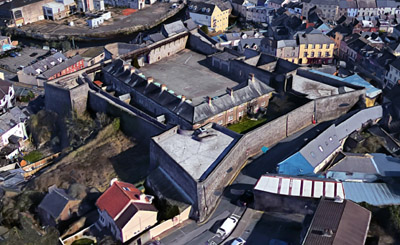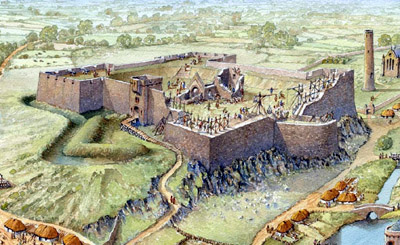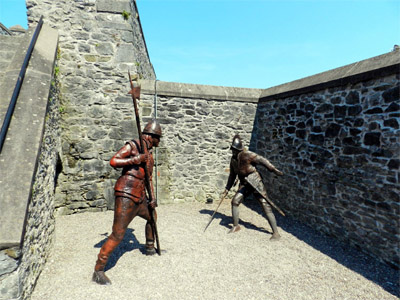 |
Elizabeth Fort
Cork, Ireland, UK
|
|
 |
Constructed: 1601, 1624-1626, 1650
Used by: England, Ireland
Conflict in which it participated:
Williamite War
|
We're all familiar with what happened in the English Channel in 1588, right? If not, we can briefly summarize by saying that Spain, in the embodiment of its Armada, attempted to invade England to punish it for daring to crown as its monarch Queen Elizabeth I (1533-1603), an actual, breathing Protestant. A combination of weather, the English Navy and poor Spanish planning left the Armada floating and/or sinking in disarray.
|
 |
|
|
There was plenty o' fortification constructed to protect Cork Harbour from whomsoever might endeavor to conquist it. Click here to read about all of Cork's defenses!Spain's King Phillip II (1527-1598), confounded by the pipsqueakery of England's navy, hatched a plan to ally with Irish Catholics, who were just as invested in ridding the earth of Elizabeth and her ilk as was Spain. A force of 4000 seasick Spaniards landed at Kinsale, Ireland in 1601, linked arms with some Irish folks, and then proceeded to be pounded into inglorious oblivion by English artillery. Though a clear English victory, this alarming invasion and its suggestion that the Spanish were not giving up on their hope to do away with Elizabeth, instigated a bonanza of English starfort construction! Charles Fort and James Fort were swiftly built on either side of Kinsale Harbour, and the most Elizabethan starfort of them all got its start in Cork. |
The citie of Corke, as it appeared at the end of the 16th century, just prior to the construction of Elizabeth Fort. Citie walls! Artillerye sticking out in places! |
 |
The first folks to settle in Cork were monks, in the 6th century AD. Viking settlers established a trading port there in the early 10th century, presumably having eaten the monks. Actually, the monks and Vikings somehow existed side-by-side in this brave new world.
The citie grewe, and was completely walled sometime in the Middle Ages. Ireland's larger cousin to its east (which was England) was also a greedy cousin, and had officially nabbed the smaller island nation by the end of the 16th century. |
|
Sir George Carew (1555-1629), who had filled many positions of importance for Queen Elizabeth, was appointed President of Munster in 1600...which might confuse you if you wondered why an English Queen was appointing presidents of a German city, but oh you silly person, Munster is also the name of the province in Ireland in which Cork is located. It was Carew's order that a fort be built on the high ground to the city's south. How nice, thought the Munsterians, our new president means to protect us! Of course not, this fort was intended to control the city of Cork. But it was also a reaction to the appearance of artillery on the battlefields of Europe, a process which had been developing rapidly through the 16th century. Cork's city walls and castle had been plenty of protection through the Middle Ages, but in an age when an enemy could put artillery on nearby high ground, one must fortify the high ground before that enemy gets there!
Named for the Queene, the first Elizabeth Fort was built around an existing church, and was an earth, timber 'n' stone rectangle with a few small bastions and a "recessed demilune." The residents of Cork folded their arms and glared at this representation of English power until 1603, when they rioted, attacked Elizabeth Fort, seized the weapons therein and left severe damage in their wake. James I (1566-1625) had ascended to the English throne in March of 1603, and the Irish were convinced that he would not be the benevolent, tolerant ruler that Elizabeth had been...ergo, they reasoned, let's ensure his enmity by destroying this fort!
|
James may or may not have even noticed, but Carew was not amused. Elizabeth Fort was rebuilt of stone in 1626, which expense was charged to the city. The new version was of the (now) classic four-bastioned, square starfort design. The church around which the original fort had been built was removed, and the whole enterprise was surrounded by a dry ditch. In 1625, Charles I (1600-1649) was crowned King of England. King and Parliament squabbled, mostly about Charles' dogged determination that he would not have his (occasionally ridiculous) royal decisions moderated in any way by those kooks in Parliament. Folks declared violent preferences for either the Royalists or Parliamentarians, and whap bam, there was the English Civil War (1642-1651)...or at least a heavily simplified version thereof, for those of us in the Western Hemisphere with short attention spans. Don't worry, there are plenty of persons in the Eastern Hemisphere typing up massively simplified accounts of the American Civil War as you read this.
|
 |
Ye Olde Forte of the Corke! Nicholas Pynnar's 1626 plan for Elizabeth Fort. Actually, the raised artillery platform on the right of this drawing didn't come into being until around 1650, sooo one might wish to be skeptical of the description! Also, half-bastions on the northern side, slightly similar to Magazine Fort in Dublin and Fort Dorchester in South Carolina...maybe the English felt that their colonial forts didn't deserve full bastions? |
|
Parliament, in the person of Oliver Cromwell (1599-1658), later to be self-crowned as Lord Protector of England, was (were?) victorious in this shindig, and in the process Charles I was tried, found guilty of High Treason, and beheaded in 1649. Yippee, said the Parliamentarians and any remaining Royalists who did not wish to also be beheaded, but many Royalists had fled to Ireland, from whence they hoped to swoop back to England and restore the monarchy: Charles II (1630-1685) had been crowned King of Ireland in 1649, and would have been more than happy to plop himself right back down on the English throne, should the opportunity arise.
Cromwell brought his New Model Army to Ireland, also in the busy year of 1649. Cork was held by Royalists, who certainly must have occupied Elizabeth Fort...but the town's garrison defected to the Parliamentarians in 1650. At the order of Cromwell himself, Elizabeth Fort's walls were heightened, and its most distinctive feature, its raised artillery platform overlooking the town (now visible as the empty, bulbous protuberance sticking up from the fort's northern curtain wall), may have been added at this time: Apologies for the wishy-washiness on this matter, but I'm finding conflicting information about that platform.
|
 Elizabeth Fort from the southwest. The River Lee is visible at top left. Elizabeth Fort from the southwest. The River Lee is visible at top left. |
 |
Ireland found itself in a similar situation 40 years later, when another English king, James II (1633-1701), arrived in Ireland at the head of a French army, along with Irish, Scottish and English volunteers...with whom he hoped to restore himself to the English throne.
England's monarchy had been reestablished in 1660, but things remained unbalanced. A fun variety of religious issues caused James to be superceded by William III (1650-1702) in 1689: Which returns us to James in Ireland with a bunch of armed Frenchmen.
|
|
William landed in Ireland in 1690 with his own international army, and the fight was on. The Williamites made it to Cork in October of 1690, predictably set up artillery on nearby high ground and pummelled the city walls. Sharpshooters set up in a nearby church steeple, from which they were able to fire into our beleaguered starfort...killing it's Jacobite (James-supporting) commandant. After four days of siege, Cork's walls were breached, and the city, and fort, surrendered. Irish Catholics, again having hitched their horse to a losing cause, did not fare well in the aftermath of the Williamite War (1688-1691).
|
Elizabeth Fort was no longer thought of as an entity that might defend the city of Cork, as it had done nothing to actually defend the city of Cork in this most recent fracas...plus it hadn't really been built with the intent of keeping folks out of the city, but rather to control what happened within. It did remained garrisoned through the 18th and 19th centuries, however: An army barracks was built within the fort in 1719 which, together with the barracks built across the street from the fort in 1698, housed 750 men.
In 1806 a new army barracks was built on the north side of the city, and Elizabeth Fort was repurposed as...those of us who are familiar with the history of European forts will see this one coming...a prison! Those lucky rapscallions sentenced to transportation, exile to New South Wales, Australia and other scenic parts of the British Empire, were held at our fort until they could be unceremoniously pitched onto a ship.
|
 |
 The construction of Elizabeth Fort, 1624, by Philip Armstrong. Images such as this one are at odds with the dating of the raised artillery platform on the fort's north side that I find at the usually-assumed-to-be-reliable Fortified-Places.com, which I've always viewed as an impeccable source, since the English gentleman who put it together has been to all of these forts. The construction of Elizabeth Fort, 1624, by Philip Armstrong. Images such as this one are at odds with the dating of the raised artillery platform on the fort's north side that I find at the usually-assumed-to-be-reliable Fortified-Places.com, which I've always viewed as an impeccable source, since the English gentleman who put it together has been to all of these forts.
Click the image to see the whole thing, it's really quite stunning! |
|
Up to 250 convicts at a time were held at Elizabeth Fort until 1837, when Australia sunk into the sea under the weight of all those transported British people. An 1845 potato blight set off the Great Famine (1845-1849), which struck particularly hard in Ireland's southern regions, which is where Cork is. Elizabeth Fort, at that time a Royal Irish Constabulary (RIC) station, was one of ten food depots within the city, feeding up to 20,000 people every day.
The Royal military returned to Elizabeth Fort in 1890, when it became a Cork City Artillery post. Modern, breech-loading guns were mounted overlooking the city, once again in the interest of controlling the increasingly independence-minded city.
|
 Today, the interior of Elizabeth Fort is populated with entertaining fellows such as these: Life-sized, realistic statuary representing guys preparing to hack at one another. Today, the interior of Elizabeth Fort is populated with entertaining fellows such as these: Life-sized, realistic statuary representing guys preparing to hack at one another. |
 |
The Irish Revolutionary War (1919-1921) brought the dreaded Black and Tans to Elizabeth Fort. An auxiliary force of the RIC, the Black and Tans developed a reputation for murderous brutality in their efforts to quell the Irish desire for Home Rule, or self-governance.
Once Ireland was granted that independence from Great Britain, it wasted no time in initiating another war amongst itself! The Irish Civil War (1922-1923) pitted the Irish Republican Army (IRA) against Ireland's Provisional Government, over the issue of the Anglo-Irish Treaty, which made Ireland an independent nation within the British Empire, like Canada. While most Canadians would point out that this arrangement worked out pretty well for them, the IRA was having none of it. |
|
It was likely due to its association with the hated Black and Tans that Elizabeth Fort's interior buildings were burned by "Anti-Treaty forces" in August of 1922. This occurred when those forces were leaving the city of Cork, chased out by the Government's army. The fort's interior was rebuilt in 1929, and was occupied by the Garda Síochána, Ireland's police force. An air raid shelter was built in Elizabeth Fort during the Second World War (1939-1945), despite Ireland's neutrality in that conflict: No bombs fell on Cork. The Garda continued to use our fort as a police station until 2013, and in 2014 it was handed over to the Cork City Council, which has been working ever since on developing Elizabeth Fort into a tourist attraction. Several events and festivals have been held in the fort in recent years, and it is open six days a week (closed Mondays), with free admission for visitors. Cork Harbour being as awesome as it is, it naturally developed its own constellation of defensive fortifications in addition to Elizabeth Fort: Please check out Starforts.com's Fortifications of Cork page should you wish to learn more. A hearty muchas gracias to starfort finder Jeff Henry, who alerted us to the presence of Elizabeth Fort!
|
|
|
|
|
|
 |




